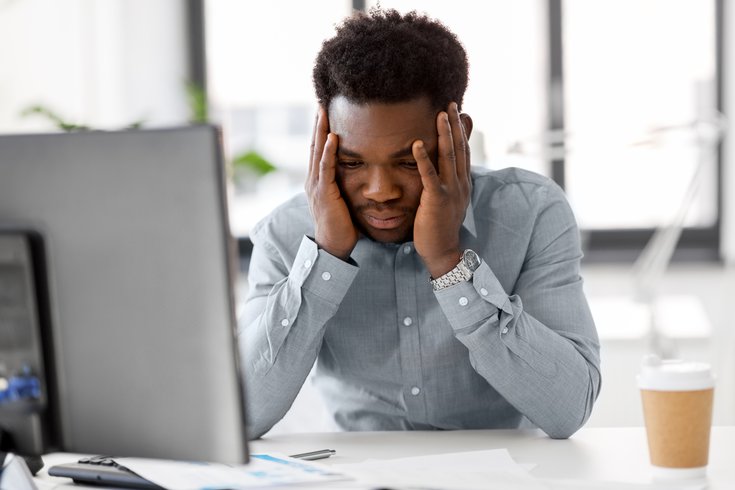
September 21, 2022
 Source/Image licensed from Ingram Image
Source/Image licensed from Ingram Image
The National Institute of Mental Health estimates that about 31% of U.S. adults will experience an anxiety disorder at some point in their lives. The U.S. Preventive Services Task Force has issued a draft recommendation that adults under age 65 undergo regular screenings.
For the first time, the U.S. Preventive Services Task Force is recommending adults under age 65 undergo regular anxiety screenings.
The draft recommendation, which must enter a public comment period before it is finalized, comes after the COVID-19 pandemic exacerbated an already burgeoning mental health problem in the United States. The task force – a group of independent medical experts whose recommendations help guide doctors' decisions – also maintained its 2016 recommendation that adults be screened for depression.
Research suggests anxiety disorders often go undetected by primary care doctors. One study cited by the task force estimated that the median time for initiating anxiety treatment is 23 years. Routine screening may help primary care doctors identify early signs of anxiety.
The task force prioritized an anxiety screening recommendation "because of its public health importance, especially with the increased focus on mental health in this country that we've been having for the past few years," task force member Lori Pbert, a psychologist at the University of Massachusetts, told CNN.
The task force initially started deliberating on the possible benefits of routine anxiety screening before the COVID-19 pandemic began. Since then, doctors have reported a surge in new cases of anxiety and depression.
Though adults ages 18-44 were the least likely to receive mental health treatment in 2019, they had become the most likely by 2021, according to the U.S. Centers for Disease Control and Prevention.
"COVID has taken a tremendous toll on the mental health of Americans," Pbert told The Washington Post. "This is a topic prioritized for its public health importance, but clearly there's an increased focus on mental health in this country over the past few years."
Under the recommendation, adults ages 19 to 64 who have never been diagnosed with a mental health disorder should receive regular anxiety screenings. That includes pregnant or postpartum women.
The task force said it did not find enough evidence to support anxiety screenings in adults over age 65 or suicide risk screenings among adults. Some anxiety symptoms – trouble sleeping, pain and fatigue – also are common aging symptoms, making it difficult to distinguish anxiety.
In April, the task force recommended anxiety screening among children ages 8 to 18. The mental health crisis among children has been particularly exacerbated by the pandemic.
Depression screenings are recommended for adults ages 18 and over who do not have a mental health disorder and are not exhibiting any of the recognized signs of depression or suicide risk. People who are showing signs should be connected to treatment immediately.
Because of a lack of data, the task force didn't make any recommendations on when and how often the screenings for adults should be conducted. The majority of anxiety and depression screenings include questionnaires about symptoms. The task force recommends any positive result be followed by additional assessments to confirm diagnosis.
Because of a shortage of mental health providers, some experts say these recommendations will be hard to put into practice without more resources. Patients already have long wait times to find a therapist who can help them.
"Screening is great, but with a dire shortage in the workforce, it's perplexing unless there are plans for increased funding of clinicians," Eugene Beresin, a psychiatrist at Massachusetts General Hospital, told The Washington Post.
In its draft recommendation, the task force acknowledged the challenges of getting everyone the mental health care they need, citing staff shortages and the persistence of health inequities among Black and Hispanic communities.
Anxiety is defined as a sustained and excessive worry that a person cannot control. Some people have anxiety over the anticipation of a future threat while others have anxiety over everyday social situations. Anxiety can manifest itself in many ways including excessive worry, fatigue, irritability, panic attacks, paranoia, poor concentration, sleep disturbance, chest pain, upset stomach, headache, increased heart rate, shortness of breath and shaking.
The National Institute of Mental Health estimates that about 31% of U.S. adults will experience an anxiety disorder at some point in their lives. Types of anxiety disorders include generalized anxiety disorder or chronic anxiety, obsessive-compulsive disorder, agoraphobia, panic disorder, post-traumatic stress disorder and social anxiety disorder.
Treatment for anxiety disorders usually involves a combination of psychotherapy and medication, according to the Mayo Clinic. Deep breathing, exercise, journaling and meditation can help reduce anxiety.
Melissa Lewis-Duarte, a wellness coach in Scottsdale, Arizona, told the Associated Press, that rhythmic breathing, meditation and making a daily list of three things that she is grateful for helped ease her anxiety.
"It's difficult to prioritize self-care, but that's what's necessary," she said.